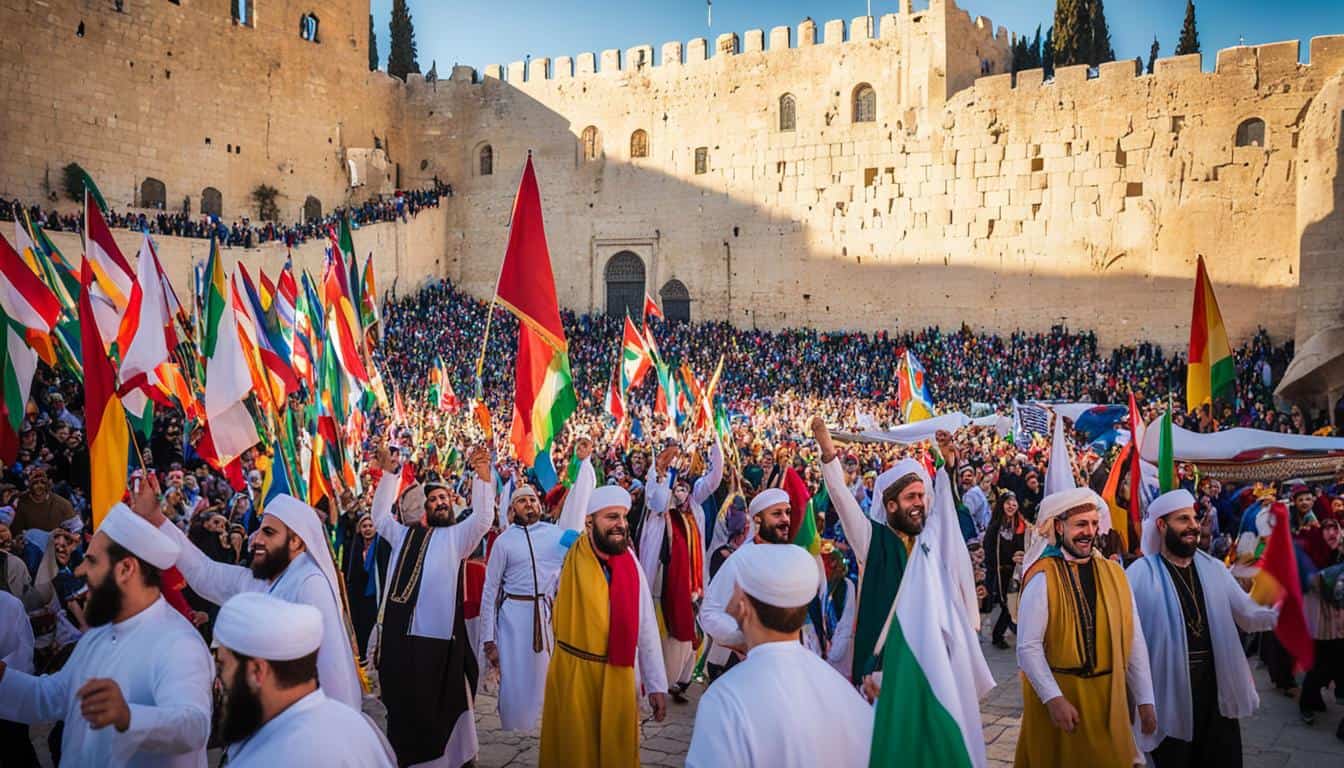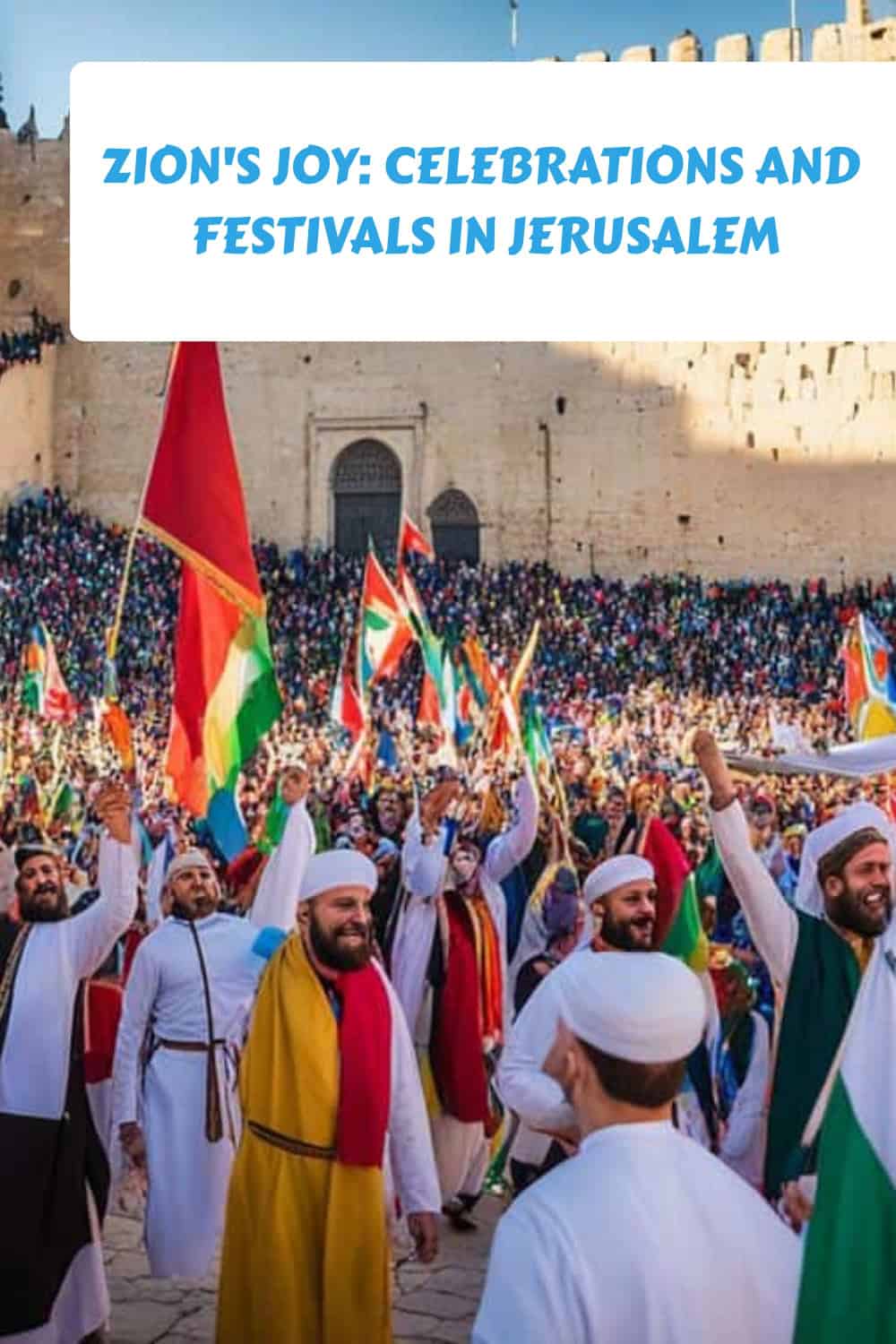Table of Contents
Have you ever wondered how celebrations and festivals in Jerusalem can embody Zion’s Joy?
It’s time to explore the rich tapestry of ancient traditions and timeless spiritual truths that converge in the heart of this extraordinary city.
From Passover to Purim, from Pentecost to the Feast of Tabernacles, Jerusalem beckons you to experience joy and spiritual connection like never before.
So, are you ready to delve into the captivating world of celebrations and festivals that define Zion’s Joy in Jerusalem?
Passover and the Last Supper: Connecting Old Traditions with New Promises
Passover, a significant Jewish festival commemorating the liberation of the Israelites from slavery in ancient Egypt, holds profound spiritual and historical significance. For Christians, Passover takes on an added layer of meaning through the lens of Jesus’ Last Supper in Jerusalem.
The Last Supper, which Jesus shared with his disciples, was a Passover meal that marked the beginning of the events leading to his crucifixion and resurrection. In this poignant moment, Jesus not only honored the age-old tradition but also redefined its purpose and symbolism for his followers.
“And he took bread, and gave thanks, and brake it, and gave unto them, saying, This is my body which is given for you: this do in remembrance of me. Likewise also the cup after supper, saying, This cup is the new testament in my blood, which is shed for you.” – Luke 22:19-20
With these words, Jesus established a new covenant, forever linking the Passover feast with his sacrificial death and the promise of salvation for all who believe in him.
The old tradition of commemorating the deliverance from physical bondage in Egypt now pointed to a greater deliverance from the bondage of sin through the sacrifice of Christ.
The Last Supper beautifully exemplifies the interconnectedness and continuity of the Jewish and Christian faiths. It underscores the significance of Jesus’ role as the Messiah, who fulfilled the prophecies of the Passover lamb and brought forth new promises of redemption and eternal life.
Passover and the Last Supper: A Comparison
| Passover | Last Supper |
|---|---|
| Commemorates the liberation of the Israelites from slavery in Egypt | Established a new covenant through Jesus’ sacrifice |
| Symbolizes deliverance from physical bondage | Symbolizes deliverance from the bondage of sin |
| Focuses on the sacrifice of the Passover lamb | Points to Jesus as the ultimate sacrificial Lamb of God |
| Promises temporal freedom | Promises eternal salvation |
By closely examining the similarities between Passover and the Last Supper, we gain a deeper understanding of how Jesus’ actions and teachings were intricately connected to the rich tapestry of Jewish traditions.
This connection enables us to appreciate the significance of the Passover feast within the context of our Christian faith.
As we partake in the communion meal today, we not only remember the historical events of the Last Supper but also embrace the transformative power of Jesus’ sacrifice, which offers us new life and eternal promises.
Passover and the Last Supper serve as a reminder of the unbroken thread that ties us to God’s redemptive plan throughout history and the newness of life we find in Christ.
Next, we will explore the celebration of Pentecost in Jerusalem and its relation to Jesus’ mission. Join us as we discover the transformative power of this festival and the significance it holds in understanding the work of the Holy Spirit.
Pentecost: From Sinai to the Upper Room
As we continue our exploration of the vibrant celebrations in Jerusalem, we now turn our attention to Pentecost. This festival holds significant meaning in relation to Jesus’ mission and the transformative power of the Holy Spirit.
Pentecost finds its roots in the story of the Israelites receiving the law at Mount Sinai. Just as God descended upon the mountain and gave Moses the commandments, Pentecost commemorates the outpouring of the Holy Spirit upon the disciples in the Upper Room.
It is a festival that bridges both the old and the new, connecting the ancient traditions of Sinai with the transformative work of the Holy Spirit in the New Testament era. The Holy Spirit, often symbolized as a mighty wind and tongues of fire, empowered the disciples to boldly proclaim the message of Jesus to people of all nations.
“And suddenly there came a sound from heaven as of a rushing mighty wind, and it filled all the house where they were sitting. And there appeared unto them cloven tongues like as of fire, and it sat upon each of them. And they were all filled with the Holy Ghost, and began to speak with other tongues, as the Spirit gave them utterance.” – Acts 2:2-4 (KJV)
This powerful outpouring of the Holy Spirit during Pentecost marked the birth of the early Christian Church and the beginning of a new era of spiritual empowerment. Through the Holy Spirit, believers were equipped with spiritual gifts and enabled to share the love and message of Jesus with the world.
The symbolism of Pentecost extends beyond the historical event and holds profound spiritual significance today. Just as the law was given at Sinai, the Holy Spirit now writes God’s law upon the hearts of believers, empowering them to live a life of obedience and holiness.
Furthermore, Pentecost serves as a reminder of the unity and diversity within the body of Christ. As people from different nations and languages gathered in Jerusalem during the festival, the Holy Spirit enabled them to understand and communicate with one another, fostering a sense of unity among believers.
The Transformative Power of Pentecost
Pentecost is a celebration that encapsulates the transformative power of the Holy Spirit. Through the Spirit, lives are changed, hearts are renewed, and the message of salvation continues to be proclaimed throughout the world.
The outpouring of the Holy Spirit during Pentecost serves as a reminder that the work of God is not confined to a particular time or place. It is an ongoing, dynamic force that transcends cultural and historical boundaries, uniting believers in a common faith and mission.
As we reflect on the significance of Pentecost, let us embrace the transformative power of the Holy Spirit in our own lives. May we be filled with His presence, empowered to share the message of Jesus, and united with believers around the world.
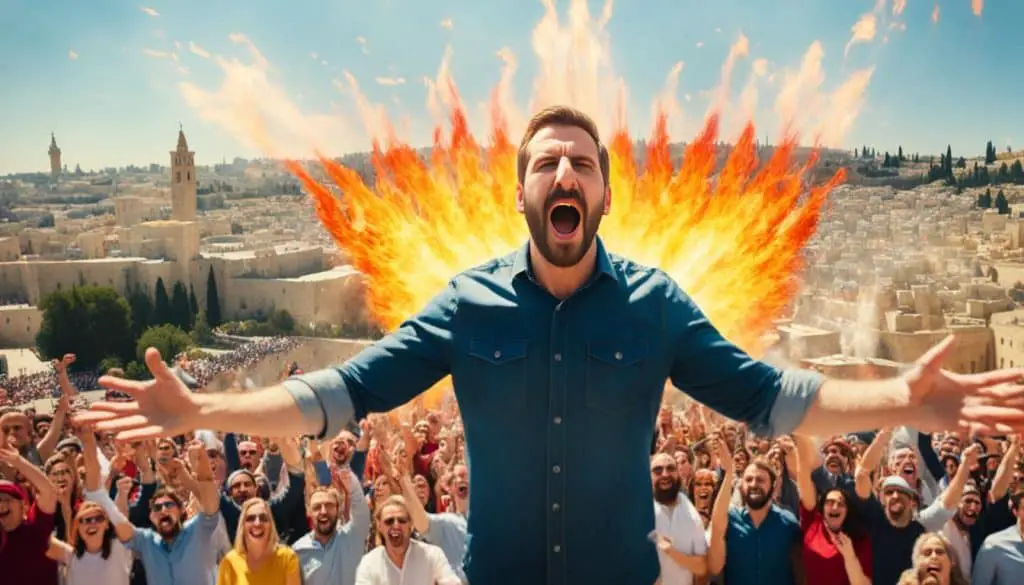
| Pentecost | Sinai | Upper Room | Holy Spirit |
|---|---|---|---|
| Commemorates the outpouring of the Holy Spirit upon the disciples | Symbolizes the giving of the law by God to Moses | The location where the disciples received the Holy Spirit | The empowering presence of God in believers |
| Birth of the early Christian Church | The establishment of Mosaic law as the foundation of Israel’s faith | The starting point of the disciples’ mission to spread the gospel | Equips believers with spiritual gifts and enables them to live a God-honoring life |
| Emphasizes the unity and diversity within the body of Christ | Unites the Israelites under the covenant with God | Brings believers together in fellowship and mutual support | Allows believers to experience a personal relationship with God |
Feast of Tabernacles: Jesus as the Living Water
The Feast of Tabernacles holds deep symbolism in Jerusalem, particularly when Jesus spoke of himself as the living water.
This ancient festival, also known as Sukkot, is a time of joyful celebration and remembrance. It commemorates the Israelites’ journey through the wilderness and their reliance on God’s provision for sustenance.
During this festival, people would construct temporary dwellings called sukkahs, representing the impermanence of earthly life and the dependence on God for protection and provision.
Every day, water was drawn from the Pool of Siloam and poured out in the Temple, accompanied by songs, prayers, and rejoicing.
It was within this context that Jesus boldly declared, “If anyone thirsts, let him come to me and drink.
He who believes in me, as the Scripture has said, out of his heart will flow rivers of living water” (John 7:37-38). In these words, Jesus not only affirmed his identity as the Messiah but also offered a profound spiritual truth.
“The Feast of Tabernacles is a vivid illustration of Jesus’ role as the
source of eternal life and ultimate fulfillment. Just as water is essential for physical life, Jesus is the source of spiritual life and satisfaction that quenches the deepest longings of our souls.”
By identifying himself as the living water, Jesus connected the physical symbol of water to a spiritual reality. Through belief in him, individuals would receive eternal life and experience a renewal of their inner being.
This promise echoes the words of the prophet Isaiah: “With joy you will draw water from the wells of salvation” (Isaiah 12:3).
Jesus’ choice to associate himself with the Feast of Tabernacles was deliberate. He reclaimed and redefined this significant festival, revealing himself as the embodiment of God’s provision, sustenance, and spiritual refreshment.
In doing so, Jesus invited all those who thirsted for truth and fulfillment to come to him.
As we reflect on the Feast of Tabernacles in Jerusalem and Jesus’ role as the living water, we are reminded of our own spiritual thirst.
We recognize that the world offers temporary pleasures that do not satisfy the deep longing within us. Only Jesus, the one who offers eternal life and fulfillment, can truly quench our thirst.
Key Teachings of Jesus during the Feast of Tabernacles:
- Jesus as the source of eternal life and spiritual fulfillment (John 7:37-38)
- The invitation to come to Jesus and drink (John 7:37)
- The promise of the Holy Spirit as living water within believers (John 7:39)
| Symbolism | Significance |
|---|---|
| The sukkah (temporary dwelling) | Dependence on God’s provision and protection |
| Drawing water from the Pool of Siloam | Remembrance of God’s provision in the wilderness |
| The pouring out of water in the Temple | Celebration of God’s ongoing sustenance |
The Dedication (Hanukkah): The Light of the World in the Festival of Lights
During the festive season of Hanukkah, Jerusalem becomes a beacon of celebration and illumination. In the midst of this joyous occasion, the presence of Jesus shines brilliantly, embodying the true meaning of the festival.
Just as the Hanukkah lights dispel darkness, Jesus, the light of the world, brings hope and salvation to all.
Hanukkah, also known as The Dedication, commemorates the rededication of the Second Temple in Jerusalem after its desecration.
This eight-day festival holds profound significance for both Jews and Christians, symbolizing resilience, miracles, and the triumph of light over darkness.
For Christians, Hanukkah captures the essence of Jesus’ identity as the light of the world. His presence in Jerusalem during this sacred time signals a divine connection between the festival and his mission on earth.
Just as the menorah is kindled each night, Jesus brings spiritual illumination, guiding humanity out of the shadows and into the brilliance of God’s love and grace.
One of the most significant accounts of Jesus’ involvement in Hanukkah is found in the New Testament. In the Gospel of John, Jesus attends the festival and declares, “I am the light of the world. Whoever follows me will never walk in darkness but will have the light of life” (John 8:12, KJV).
These words encapsulate the profound message of Hanukkah, emphasizing Jesus’ role as the illuminator and bringer of eternal life.
Just as the Hanukkah lights are kindled to dispel darkness, Jesus offers deliverance from spiritual darkness and brings hope to all who believe in him. Through his teachings, miracles, and sacrificial love, Jesus illuminates the path to salvation and offers a renewed sense of purpose and joy.
“As we celebrate Hanukkah, we reflect on the significance of Jesus, the light of the world. Like the menorah, which symbolizes the eternal flame of God’s presence, Jesus brings divine light and hope into our lives.”
During Hanukkah, the festival of lights, we are reminded of Jesus’ transformative power and his ability to overcome the darkness that often engulfs our world.
As we kindle the Hanukkah lights, let us also ignite the flame of faith in our hearts, allowing Jesus to dispel the shadows and guide us into a life filled with his abundant grace and love.
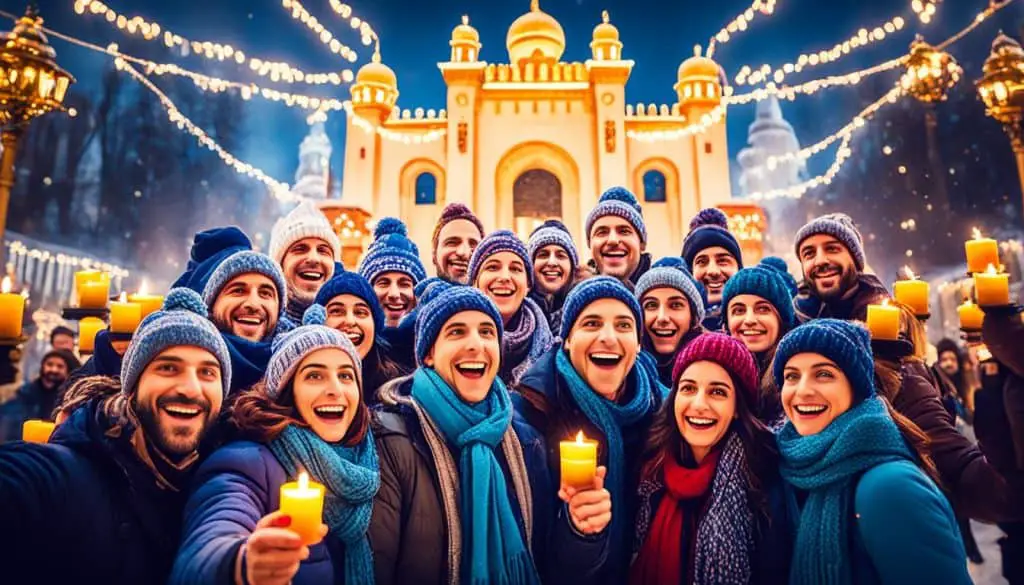
Purim: Deliverance and Victory Prefiguring the Ultimate Redemption
As we delve into the story of Esther and the celebration of Purim in Jerusalem, we witness a powerful narrative of deliverance and victory.
Purim commemorates the events described in the biblical book of Esther, where the Jewish people were threatened with annihilation by the wicked Haman.
Through the bravery of Queen Esther and the intervention of God, the Jewish people were ultimately delivered from destruction.
The festival of Purim serves as a reminder of God’s faithfulness in times of crisis and His ability to work through unexpected means to bring about redemption.
It is a celebration of the triumph of good over evil, light over darkness, and life over death. In this sense, Purim prefigures the ultimate redemption brought about by Jesus Christ.
Just as Esther’s actions saved her people from destruction, Jesus’ sacrificial work on the cross brought about deliverance and victory for all humanity. Through His death and resurrection, Jesus triumphed over sin and death, offering redemption and eternal life to those who believe in Him.
“For God so loved the world that he gave his one and only Son, that whoever believes in him shall not perish but have eternal life.” – John 3:16 (KJV)
Purim, with its themes of deliverance and victory, offers a glimpse of the redemptive work of Jesus. In both the story of Esther and the life of Jesus, we see ordinary individuals being used by God to bring about salvation.
We witness God’s sovereignty at work, guiding the events that lead to deliverance and ultimately pointing to the ultimate redemption found in Jesus.
The celebration of Purim in Jerusalem is marked by various customs, including reading the Book of Esther, exchanging gifts, giving to the poor, and feasting on traditional delicacies like hamantaschen.
These customs serve as reminders of the deliverance experienced by the Jewish people and the ongoing faithfulness of God.
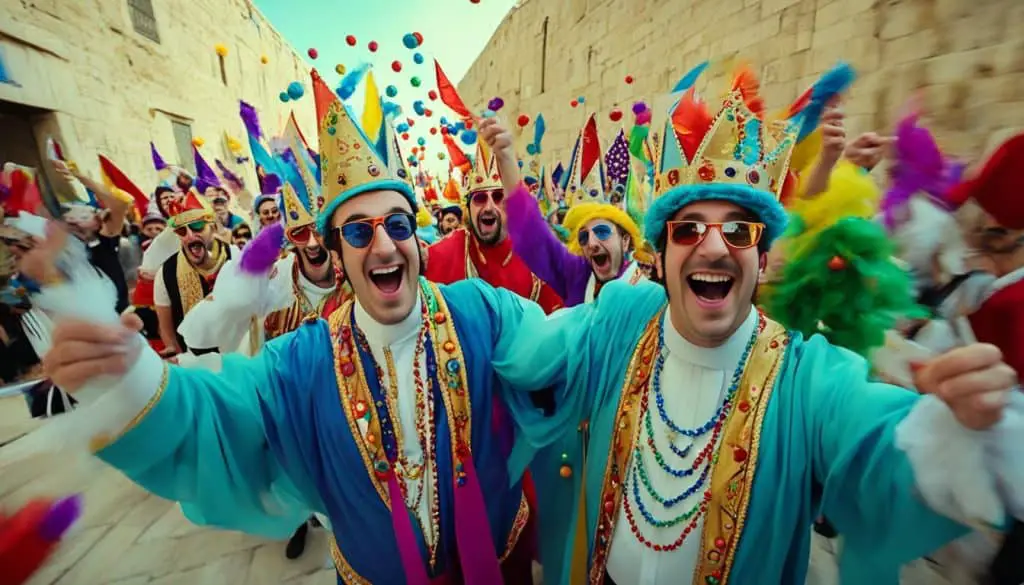
| Symbol | Meaning |
|---|---|
| Megillah (Book of Esther) | Read aloud to commemorate the story of Esther and the deliverance of the Jewish people |
| Mishloach Manot | Exchanging gifts of food with friends and neighbors as a symbol of unity and friendship |
| Tzedakah | Giving to the poor and those in need, embodying the spirit of compassion and care |
| Hamantaschen | Triangular pastries filled with sweet fillings, representing Haman’s hat or pockets |
Through the celebration of Purim in Jerusalem, we are reminded of God’s deliverance and victory in the face of adversity and His redemptive work through Jesus Christ.
Just as Esther’s story transformed the lives of the Jewish people, Jesus’ sacrificial love and triumph over death offer true deliverance and victory for all who trust in Him.
Purim foreshadows the ultimate redemption that comes through Jesus, bringing hope, joy, and eternal life.
Trumpets (Rosh Hashanah): The Kingly Coronation and Its Eschatological Echoes
When it comes to the celebration of Rosh Hashanah in Jerusalem, the blowing of trumpets holds profound symbolism.
This festival not only marks the beginning of the Jewish New Year but also inspires contemplation of Jesus’ eventual triumphant return as both a king and a judge.
The sound of the trumpets echoes throughout the city, signaling a time of introspection, repentance, and renewal.
As you stand in the midst of this momentous occasion, you can’t help but reflect on the eschatological teachings that emphasize Jesus’ significant role in the final judgment.
Just as the trumpets announce the crowning of a king, Rosh Hashanah invites us to ponder Jesus’ kingly coronation when he returns in glory.
It reminds us to remain vigilant and to prepare our hearts for his triumphant second coming, knowing that he will establish his kingdom with righteousness and justice.
“Then shall the LORD go forth, and fight against those nations, as when he fought in the day of battle. And his feet shall stand in that day upon the mount of Olives, which is before Jerusalem on the east, and the mount of Olives shall cleave in the midst thereof…and the LORD my God shall come, and all the saints with thee.” – Zechariah 14:3-5
As you experience the vibrant festivities of Rosh Hashanah in Jerusalem, you can’t help but be reminded of the significance of this season and the anticipation of Jesus’ triumphant return. The blowing of trumpets serves as a call to wake up, to be ready, and to eagerly await the coming of our Savior.
The Symbolism of Trumpets in Rosh Hashanah
Throughout the Bible, trumpets are often associated with significant events, divine announcements, and battles. In the Book of Numbers, trumpets were used to gather the people, signal the start of feasts, and call them to assemble.
On Rosh Hashanah, the sound of the shofar, a ram’s horn, resonates through the air, evoking a sense of awe and reverence. It serves as a reminder that God is present and that the time of judgment draws near.
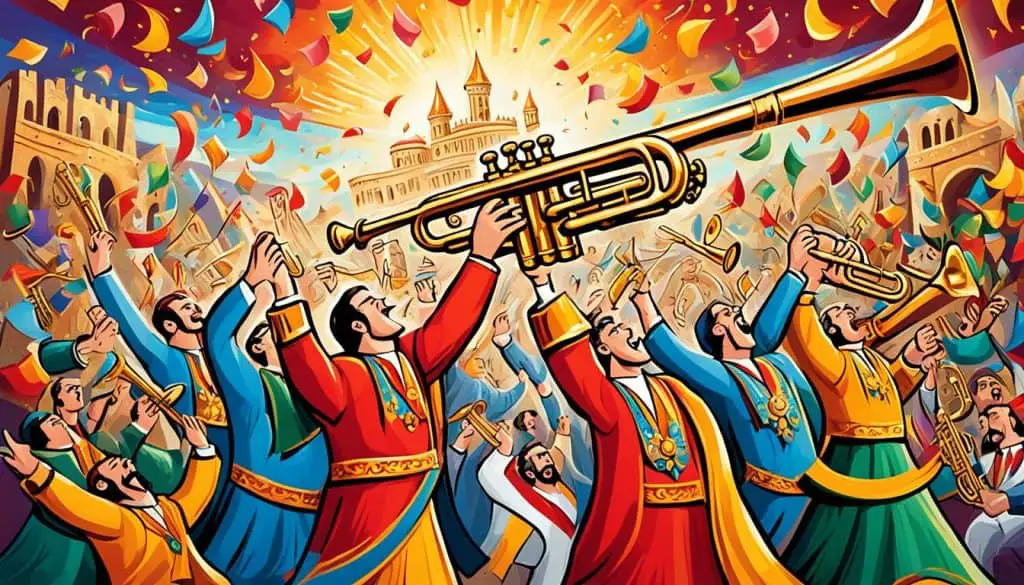
Just as the shofar was blown to announce the coronation of earthly kings, this festival carries a profound message about Jesus’ future reign as the King of Kings.
The blowing of trumpets in Rosh Hashanah foreshadows the time when Jesus will establish his eternal kingdom and fulfill the prophecies of his triumph over evil and the final judgment.
It underscores the importance of preparing our hearts and lives for that momentous event.
The Joyful Anticipation of Jesus’ Triumphant Return
Immersed in the celebrations of Rosh Hashanah in Jerusalem, you can sense the joyful anticipation among the people as they eagerly await the fulfillment of God’s promises.
The shofar’s blast carries echoes of hope, reminding us that Jesus will return with power and glory, bringing redemption and restoration.
This festival serves as a powerful reminder that we are living in a time of anticipation, a time marked by the hope and excitement of our Savior’s triumphant return.
As you witness the joyful celebration of Rosh Hashanah and hear the resounding call of the trumpets, let it ignite a deeper longing in your heart for the day when Jesus will come again.
Reflecting on the symbolism of trumpets during Rosh Hashanah in Jerusalem offers a profound understanding of Jesus’ kingly coronation and the eschatological echoes it carries.
Let this celebration inspire you to live with anticipation, knowing that Jesus will return in triumph, establish his reign, and bring about the ultimate fulfillment of God’s plan.
Yom Kippur: The Day of Atonement and the Sacrifice of Christ
In Jerusalem, the solemn observance of Yom Kippur holds great significance as the holiest day in the Jewish calendar. Known as the Day of Atonement, this sacred occasion focuses on repentance and seeking forgiveness for sins committed throughout the year.
The rituals and traditions surrounding Yom Kippur reflect the deep longing for reconciliation with God and the yearning for spiritual cleansing.
On this day, the high priest played a vital role in the atonement process. Cloaked in white garments, he entered the Holy of Holies to offer sacrifices and intercede on behalf of the people.
The entire community participated in fasting, prayer, and reflection, collectively seeking forgiveness and renewal within the covenant between God and His chosen people.
Through these acts of reconciliation, Yom Kippur showcased God’s merciful nature, offering a path to redemption and restoration. However, as Christians, we recognize that the sacrificial system of Yom Kippur merely foreshadowed the ultimate sacrifice of Jesus Christ.
“For Christ is not entered into the holy places made with hands, which are the figures of the true; but into heaven itself, now to appear in the presence of God for us: Nor yet that he should offer himself often, as the high priest entereth into the holy place every year with blood of others; For then must he often have suffered since the foundation of the world: but now once in the end of the world hath he appeared to put away sin by the sacrifice of himself.”
The sacrifice of Christ on the cross fulfilled the ultimate purpose of atonement, offering forgiveness, and reconciliation to all who believe in Him.
Through His death and resurrection, Jesus became the perfect high priest, interceding on our behalf once and for all. He became the sacrificial lamb, bearing the weight of our sins and restoring our relationship with God.
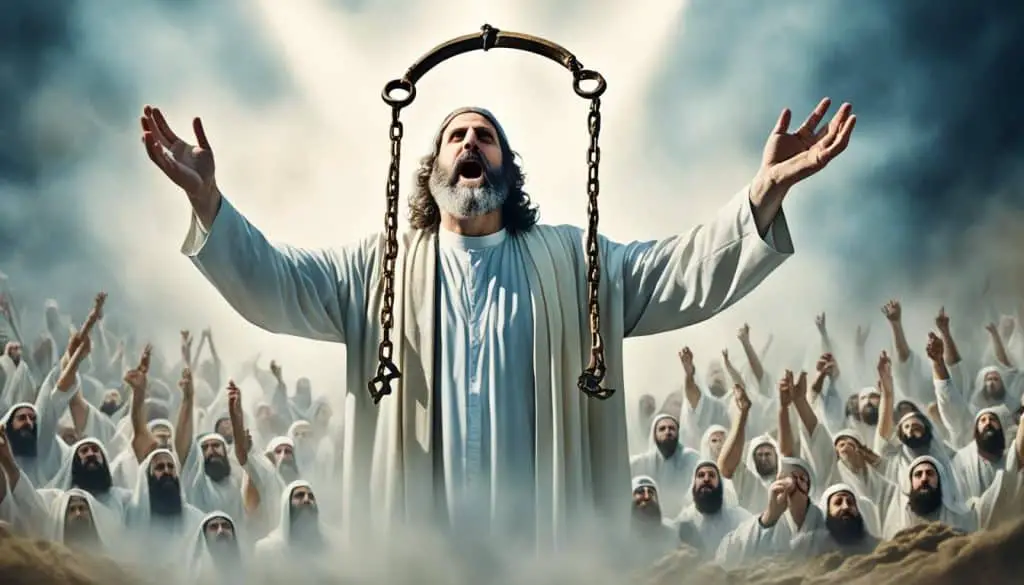
As we reflect on the solemnity and significance of Yom Kippur, we are reminded of the sacrifice of Christ and the unparalleled gift of salvation He has bestowed upon us.
Yom Kippur points us towards the ultimate redemption found in Jesus, inviting us to turn to Him for forgiveness, cleansing, and a renewed relationship with our Heavenly Father.
The Sacrifice of Christ: A Table of Comparison
| Yom Kippur | The Sacrifice of Christ |
|---|---|
| Annual observance | Once and for all sacrifice |
| Animal sacrifices | Jesus as the sacrificial lamb |
| High priest intercession | Jesus as the perfect high priest |
| Forgiveness of sins | Complete forgiveness and reconciliation |
By comparing the rituals and symbols of Yom Kippur with the sacrifice of Christ, we gain a deeper understanding of the profound impact of Jesus’ atonement.
His sacrifice surpasses the limitations of earthly rituals, opening the door for eternal forgiveness, freedom, and restoration. Through Him, we can experience true freedom from sin and find our ultimate atonement in the loving embrace of our Savior.
The Sabbath: A Weekly Reminder of Rest in Christ
As we journey through Jerusalem, we encounter Jesus’ actions and teachings during the Sabbath, prompting us to redefine the significance of this sacred day. The Sabbath serves as a weekly reminder of the rest and spiritual renewal that can be found in a relationship with Christ.
In the hustle and bustle of our daily lives, it’s easy to forget the importance of rest and reflection. However, the Sabbath provides a designated time for us to pause, disconnect from the distractions of the world, and reconnect with our Creator.
Just as God rested on the seventh day of creation, the Sabbath invites us to rest in His presence and experience the deep, soul-nourishing peace that comes from communing with Him.
“Come unto me, all ye that labour and are heavy laden, and I will give you rest.” – Matthew 11:28 (KJV)
Jesus emphasized the restful nature of the Sabbath, inviting all who are weary and burdened to find solace in Him.
In His teachings, Jesus emphasized that the true essence of Sabbath observance goes beyond legalistic rules and regulations; it is about finding spiritual rest and revitalization in a relationship with Him.
During His ministry, Jesus performed acts of healing on the Sabbath, challenging the Pharisaic interpretation of Sabbath laws. These acts of compassion and restoration showcased the heart of God, who desires for His people to experience physical and spiritual wholeness.
“And ought not this woman, being a daughter of Abraham, whom Satan hath bound, lo, these eighteen years, be loosed from this bond on the sabbath day?” – Luke 13:16 (KJV)
Jesus’ actions on the Sabbath demonstrate the freedom and deliverance that can be found in Him. He invites us to lay down our burdens, find refuge in His love, and experience the true rest that comes from embracing Him as our Lord and Savior.
The Sabbath and Grace
One of the most profound aspects of the Sabbath is its reflection of God’s grace. Just as the Israelites were commanded to observe a day of rest, we, too, are called to rest in Christ’s finished work on the cross.
The Sabbath reminds us that our salvation is not based on our own efforts, but on the grace and mercy of our Savior.
“For by grace are ye saved through faith; and that not of yourselves: it is the gift of God.” – Ephesians 2:8 (KJV)
In Jesus, we find true rest, redemption, and reconciliation with God. The Sabbath serves as a weekly invitation to enter into the rest of our Lord, acknowledging that our salvation is not achieved through our works, but through faith in Him.
As we embrace the Sabbath and rest in Christ, we experience a renewed sense of purpose, peace, and spiritual rejuvenation. It is a time to lay aside our anxieties and busyness, and allow God to restore and replenish our souls.

| Benefits of Observing the Sabbath in Christ: | Scriptural References: |
|---|---|
| Rest for the weary soul | Matthew 11:28 |
| Physical and spiritual healing | Luke 13:16 |
| Embracing God’s grace and salvation | Ephesians 2:8 |
| Renewed sense of purpose and peace | Isaiah 58:13-14 |
How do Celebrations and Festivals in Jerusalem Reflect the Idea of Divine Harmony?
The celebrations and festivals in Jerusalem are a beautiful reflection of zion’s peace in Jerusalem. These gatherings bring people together in unity, promoting a sense of harmony and spiritual connectedness. The diverse traditions and customs showcased in these events embody the idea of divine harmony, fostering a sense of peace within the city.
New Moon Festivals: The Promise of Renewal and Restoration
As we come to the conclusion of this article, we turn our attention to the monthly New Moon Festivals in Jerusalem. These celebrations hold a powerful significance as they symbolize new beginnings and offer a promise of renewal and restoration.
But what makes these festivals truly extraordinary is their connection to Jesus’ presence and promise in our lives.
Just as the moon goes through phases, waxing and waning, these festivals remind us of the cyclical nature of life and our need for constant renewal. In Jesus, we find the ultimate source of renewal and restoration.
He brings hope to the weary and offers healing to the broken. Through His presence, we can experience a fresh start and embrace the promise of new beginnings.
Jesus’ promise of renewal extends beyond mere earthly restoration. It encompasses our spiritual renewal as well. He invites us to turn to Him, to find rest and restoration for our souls. In His presence, we find healing and forgiveness, transforming us from the inside out.
So, as we reflect on the New Moon Festivals in Jerusalem, let us remember the promise of renewal and restoration that comes through Jesus. May we embrace His presence and allow Him to bring new life into every aspect of our being. May these festivals serve as a reminder of His enduring promise to renew and restore us.

